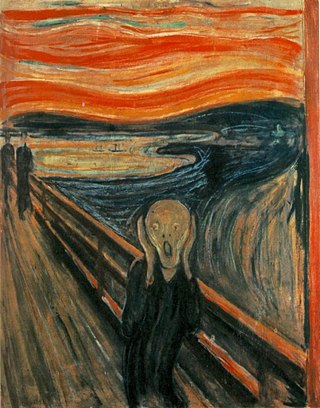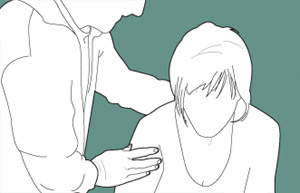Related Research Articles

Anxiety is an emotion which is characterized by an unpleasant state of inner turmoil and includes feelings of dread over anticipated events. Anxiety is different than fear in that the former is defined as the anticipation of a future threat whereas the latter is defined as the emotional response to a real threat. It is often accompanied by nervous behavior such as pacing back and forth, somatic complaints, and rumination.

A phobia is an anxiety disorder defined by a persistent and excessive fear of an object or situation. Phobias typically result in a rapid onset of fear and are usually present for more than six months. Those affected go to great lengths to avoid the situation or object, to a degree greater than the actual danger posed. If the object or situation cannot be avoided, they experience significant distress. Other symptoms can include fainting, which may occur in blood or injury phobia, and panic attacks, often found in agoraphobia and emetophobia. Around 75% of those with phobias have multiple phobias.

Anxiety disorders are a cluster of mental disorders characterized by significant and uncontrollable feelings of anxiety and fear such that a person's social, occupational, and personal function are significantly impaired. Anxiety may cause physical and cognitive symptoms, such as restlessness, irritability, easy fatiguability, difficulty concentrating, increased heart rate, chest pain, abdominal pain, and a variety of other symptoms that may vary based on the individual.

Agoraphobia is a mental and behavioral disorder, specifically an anxiety disorder characterized by symptoms of anxiety in situations where the person perceives their environment to be unsafe with no easy way to escape. These situations can include open spaces, public transit, shopping centers, crowds and queues, or simply being outside their home on their own. Being in these situations may result in a panic attack. Those affected will go to great lengths to avoid these situations. In severe cases, people may become completely unable to leave their homes.

Panic attacks are sudden periods of intense fear and discomfort that may include palpitations, sweating, chest pain or chest discomfort, shortness of breath, trembling, dizziness, numbness, confusion, or a feeling of impending doom or of losing control. Typically, symptoms reach a peak within ten minutes of onset, and last for roughly 30 minutes, but the duration can vary from seconds to hours. Although they can be extremely frightening and distressing, panic attacks themselves are not physically dangerous.

Hypochondriasis or hypochondria is a condition in which a person is excessively and unduly worried about having a serious illness. Hypochondria is an old concept whose meaning has repeatedly changed over its lifespan. It has been claimed that this debilitating condition results from an inaccurate perception of the condition of body or mind despite the absence of an actual medical diagnosis. An individual with hypochondriasis is known as a hypochondriac. Hypochondriacs become unduly alarmed about any physical or psychological symptoms they detect, no matter how minor the symptom may be, and are convinced that they have, or are about to be diagnosed with, a serious illness.

Sleep paralysis is a state, during waking up or falling asleep, in which one is conscious but is unable to move or speak. During an episode, one may hallucinate, which often results in fear. Episodes generally last no more than a couple of minutes. It can recur or occur as a single episode.

Claustrophobia is the fear of confined spaces. It can be triggered by many situations or stimuli, including elevators, especially when crowded to capacity, windowless rooms, and hotel rooms with closed doors and sealed windows. Even bedrooms with a lock on the outside, small cars, and tight-necked clothing can induce a response in those with claustrophobia. It is typically classified as an anxiety disorder, which often results in panic attacks. The onset of claustrophobia has been attributed to many factors, including a reduction in the size of the amygdala, classical conditioning, or a genetic predisposition to fear small spaces.

Aquaphobia is an irrational fear of water.

Dizziness is an imprecise term that can refer to a sense of disorientation in space, vertigo, or lightheadedness. It can also refer to disequilibrium or a non-specific feeling, such as giddiness or foolishness.
Phobophobia is a phobia defined as the fear of phobias, or the fear of fear, including intense anxiety and unrealistic and persistent fear of the somatic sensations and the feared phobia ensuing. Phobophobia can also be defined as the fear of phobias or fear of developing a phobia. Phobophobia is related to anxiety disorders and panic attacks directly linked to other types of phobias, such as agoraphobia. When a patient has developed phobophobia, their condition must be diagnosed and treated as part of anxiety disorders.
Social anxiety is the anxiety and fear specifically linked to being in social settings. Some categories of disorders associated with social anxiety include anxiety disorders, mood disorders, autism spectrum disorders, eating disorders, and substance use disorders. Individuals with higher levels of social anxiety often avert their gazes, show fewer facial expressions, and show difficulty with initiating and maintaining a conversation. Social anxiety commonly manifests itself in the teenage years and can be persistent throughout life, however, people who experience problems in their daily functioning for an extended period of time can develop social anxiety disorder. Trait social anxiety, the stable tendency to experience this anxiety, can be distinguished from state anxiety, the momentary response to a particular social stimulus. Half of the individuals with any social fears meet the criteria for social anxiety disorder. Age, culture, and gender impact the severity of this disorder. The function of social anxiety is to increase arousal and attention to social interactions, inhibit unwanted social behavior, and motivate preparation for future social situations.

Nomophobia is a word for the fear of, or anxiety caused by, not having a working mobile phone. It has been considered a symptom or syndrome of problematic digital media use in mental health, the definitions of which are not standardized for technical and genetical reasons.
Derealization is an alteration in the perception of the external world, causing those with the condition to perceive it as unreal, distant, distorted or falsified. Other symptoms include feeling as if one's environment is lacking in spontaneity, emotional coloring, and depth. It is a dissociative symptom that may appear in moments of severe stress.
Vestibular migraine (VM) is vertigo with migraine, either as a symptom of migraine or as a related neurological disorder.

Panic disorder is a mental and behavioral disorder, specifically an anxiety disorder characterized by reoccurring unexpected panic attacks. Panic attacks are sudden periods of intense fear that may include palpitations, sweating, shaking, shortness of breath, numbness, or a feeling that something terrible is going to happen. The maximum degree of symptoms occurs within minutes. There may be ongoing worries about having further attacks and avoidance of places where attacks have occurred in the past.
An anxiety threshold is the level of anxiety that, when reached, can affect a person's performance. Anxiety is an emotion, similar to fear, that can be created by insecurities in one's abilities, concerns for the future, such as financial or situational circumstances, or past memories of frightening experiences. Anxiety can affect all age groups and if fears are irrational, it may cause mental disorders. An individual's anxiety threshold can be measured by the amount of anxiety consistently manifested from situation to situation.
Falling-out is a culture-bound syndrome reported in Latin America and the Caribbean and usually brought on by stress.
Anxiety sensitivity (AS) refers to the fear of behaviours or sensations associated with the experience of anxiety, and a misinterpretation of such sensations as dangerous. Bodily sensations related to anxiety, such as nausea and palpitations, are mistaken as harmful experiences, causing anxiety or fear to intensify. For example, a person with high anxiety sensitivity may fear the shakes as impending neurological disorder, or may suspect lightheadedness is the result of a brain tumour; conversely, a person with low anxiety sensitivity is likely to identify these as harmless and attach no significance to them. The Anxiety Sensitivity Index attempts to assess anxiety sensitivity.
Caffeine-induced anxiety disorder is a subclass of the DSM-5 diagnosis of substance/medication-induced anxiety disorder.
References
- Shioiri T, Someya T, Fujii K, Noguchi T, Takahashi S (April 1997). "Differences in symptom structure between panic attack and limited symptom panic attack: a study using cluster analysis". Psychiatry Clin. Neurosci. 51 (2): 47–51. doi: 10.1111/j.1440-1819.1997.tb02906.x . PMID 9141140. S2CID 7760416.
- Katerndahl DA (1999). "Progression of limited symptom attacks". Depress Anxiety. 9 (3): 138–40. doi: 10.1002/(SICI)1520-6394(1999)9:3<138::AID-DA7>3.0.CO;2-4 . PMID 10356653. Archived from the original on 2012-12-10.
- Anxiety B.C.
- Mind Disorders
- Panic and Anxiety Disorders